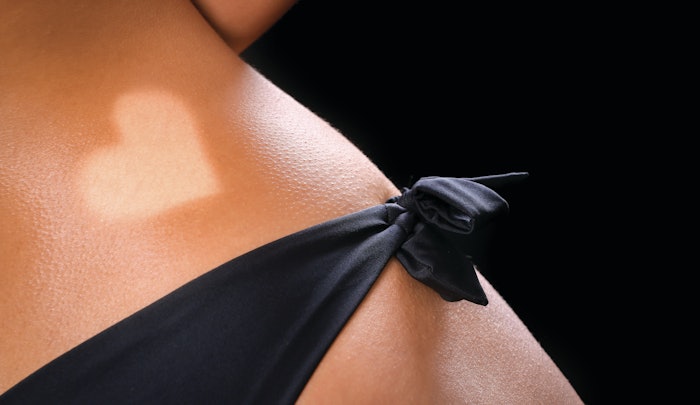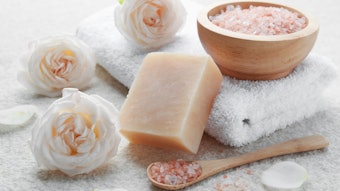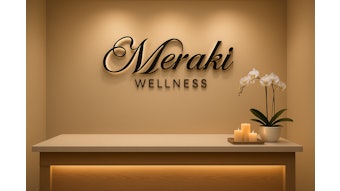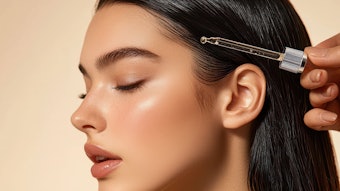
In the ever-evolving world of aesthetics, there’s one service that’s managed to stay both timeless and trendy—profitable for practitioners, addictive for clients and shockingly low overhead for what it delivers: spray tanning.
Drying – Remove your gun from the hose and use the compressed air to dry the body between applications for the most flawless result. Build-up or wet applications can look good for a few days, but often fade poorly. If space allows, keep a standing fan in your tan room so clients can dry fully after the session.
This article is only available to registered users.
Log In to View the Full Article
In the ever-evolving world of aesthetics, there’s one service that’s managed to stay both timeless and trendy—profitable for practitioners, addictive for clients and shockingly low overhead for what it delivers: spray tanning.
For clients, it’s that effortless, just-back-from-vacation glow (minus the UV damage, sunburn and regret). For estheticians, it’s one of those rare services that checks all the boxes: low cost per treatment, quick appointment times, repeat business that borders on obsession and endless potential as an easy add-on to nearly everything else you already offer.
At Beautique Salon in MA, we joke and say, “Look 15 pounds lighter, 15 times hotter in just 15 minutes—guaranteed!” One of the highest payoffs in the fastest timeframe with a nice, long-lasting result. A professional machine barely needs more than a corner of your treatment room, and the payoff? Anywhere from $45–$65 per session on average and often much more in urban markets or during peak glow seasons like weddings, proms and holidays.
In this article, we’ll dive into everything you need to know to master the art and business of spray tanning—from its quirky history and the science of DHA, to pro application tips, client prep and aftercare, common mistakes (and how to fix them), plus how to position spray tanning as a high-value, low-cost expansion of your service menu.
A Brief History
Spray tanning wasn’t always chic. In fact, when Coco Chanel accidentally popularized the “sun-kissed” look in the 1920s after a holiday on the French Riviera, tanning became a fashionable rebellion against the pale complexions that once symbolized wealth. Fast forward to the 1960s, when a researcher noticed that dihydroxyacetone (DHA), a compound derived from sugar beets, stained the skin a harmless brown. Early formulations, however, often left clients more “pumpkin patch” than golden goddess.
It wasn’t until the late 1990s and early 2000s that professional spray tanning equipment became widely available, formulas improved and celebrities started raving about their flawless spray tan glow. From red carpets to bodybuilding competitions, spray tanning went from gimmicky to mainstream. Today, it’s a billion-dollar global industry and a highly profitable niche for estheticians.
Spray tanning is more than just a faux glow—it’s a modern esthetician’s golden ticket.
The Science of Spray Tanning
Here’s where things get really fun: spray tans are basically a science experiment disguised as beauty magic. The star ingredient, dihydroxyacetone (DHA), works by reacting with amino acids in the very top layer of your skin—the stratum corneum.
The result? A chemical process called the Maillard reaction (yep, the exact same reaction that makes your morning toast golden, gives pretzels that deep brown shine and caramelizes onions).
So essentially, when you’re giving a spray tan, you’re “toasting” the skin. The difference is that it’s controlled, flattering and bronzed—never burnt. Instead of UV damage breaking down your skin, DHA creates a temporary pigment that sits on the surface. The beauty of it is that it doesn’t alter your DNA, doesn’t penetrate deeply and fades naturally as those top layers of skin shed off.
The concentration of DHA in formulas varies, usually between 6% and 14%, which is what determines how light, medium or deep the tan develops. Lower percentages give a subtle glow (perfect for beginners or pale skin tones), while higher percentages deliver that rich, “I-just-got-back-from-the-Maldives” depth, and because the reaction depends on each client’s unique skin chemistry, spray tanning is as much art as it is science—no two tans ever develop exactly the same way.
With today’s advancements—violet-based undertones, rapid-developing solutions and organic blends—spray tanning has moved far beyond the days of streaky orange disasters. Thanks to chemistry, you get to play beauty alchemist: turning colored liquid into a golden glow in just a few hours.
Types of Spray Tanning Methods
As an esthetician, you’ll encounter three main approaches:
Booth Spray Tans – Automated, quick and lower cost for clients, but less control and more impersonal.
Custom Spray Tans – You (or your staff) apply the tan with a spray gun. This is where artistry comes in: contouring, customizing shades and delivering flawless results.
Mobile Spray Tanning – Growing in popularity, especially for bridal parties or busy professionals. With a tent and portable machine, you can bring the service directly to the client.
For most estheticians, custom spray tanning is the sweet spot. It requires minimal investment, creates strong repeat clientele and allows you to charge premium pricing for your expertise.
Prep is Everything
Even the most skilled spray tan application can go sideways if the client isn’t prepped properly. Blotches, uneven color and premature fading are almost always the result of skipped steps before the client even steps into your booth.
As the professional, your role isn’t just to spray—it’s to educate and empower your clients so they get the best results every time. Consistency in client prep is key to building trust, repeat visits and raving reviews.
Key Prep Steps to Communicate
- Exfoliate 24 hours before. This removes dead skin cells, smooths the skin’s surface and ensures the DHA absorbs evenly. Morning exfoliation can leave skin a little sensitive. Make sure that if it is a repeat client, they know to remove as much of the existing tan as possible before applying more.
- Shave or wax the day before. Freshly shaved skin can be sensitive, and applying a tan immediately afterward can lead to irritation. Giving the skin a full 24 hours to rest is ideal.
- Skip lotions, oils, deodorants or perfumes on the day of the tan. Moisturizers and oils create barriers that prevent DHA from adhering evenly, while deodorants or perfumes can react with the spray solution and alter color in unwanted ways.
- Dress for success. Loose, dark clothing and flip-flops are best. Advise clients to avoid socks, bras or tight garments immediately after application if possible. Tight clothing can leave lines, rub off color or create uneven fading in those areas.
Pro Tip: Make it easy for your clients! Create a simple, branded prep-and-aftercare sheet that you can hand out or email ahead of their session. This not only reduces the need to repeat instructions every time but also gives your service a professional, polished touch. At Beautique Salon, Spa, and Lash Lounge in MA, we even have a small sign hanging in our tanning room with reminders about both prep and aftercare—an instant reference that clients love and actually follow. We also have a handy guide pinned on our Instagram page.
Proper prep is where the magic starts—when clients follow these steps, your application will glide on smoothly, the color will develop evenly and your spray tan results will wow them every single time.
The Spray Tan Session: What to Expect
Spray tanning is quick, but that doesn’t mean it’s without finesse, a smooth, professional session looks like this:
- Consultation – Ask about their goals (subtle glow vs. deep bronze), skin undertones and any special events. Provide clients instructions of what to do once you close the door.
- Barrier Cream – Apply to hands, feet, elbows and nails. These areas absorb more DHA and can look muddy without protection. (Some lines do not require this step, and some artists perfect the technique enough to skip it.)
- Attire – Most clients will go topless to avoid tan lines and will opt for a disposable thong on the bottom (though some may wish to skip for tan-line reasons). If a client does use the disposable thong and shower cap to protect their hair, adjust both before spraying to ensure the shower cap is not sitting low on the forehead or the thong isn’t sitting crooked in the back or too high on the hips. Otherwise, tan lines may show outside of a normal bathing suit bottom and give an unwanted “peep show” result.
- Application – Guide the client through poses to ensure even coverage. Move methodically—front, back, sides—with light, overlapping passes. Avoid spraying the neck directly; it will naturally get hit with overspray from the shoulders and chest. This area can feel sticky if overdone. Always ask clients if they would like their face done and warn them that it may accentuate dark spots from the sun. If spraying the face, ask clients to pull in their lips, hold their breath, and squint their eyes to avoid too much DHA entering the airways. At our salon, we say “1-2-3” and then spray the face from the front, asking the client to turn right and left so we can repeat. This way, they anticipate the spray and know it’s just a quick three-second breath hold.
Drying – Remove your gun from the hose and use the compressed air to dry the body between applications for the most flawless result. Build-up or wet applications can look good for a few days, but often fade poorly. If space allows, keep a standing fan in your tan room so clients can dry fully after the session.
Pro Tip: Buy black everything for your tan room to keep it looking clean!
- Post-care Instructions – Verbally remind the client, then hand them written guidelines for either express or classic tan. Express solutions are popular because they develop quickly. The final color depends on how long the product remains on the skin (not the % of DHA). Guide clients on when to shower to achieve their desired result. Many salons charge more for express tans as well!
A confident, professional flow creates client trust. Remember, many first-timers are nervous (and probably worried about looking like Ross on Friends). Clients can feel vulnerable in these positions or start apologizing for how their body looks, so being reassuring and kind goes a long way.
Pro Tip: Every body is beautiful—here’s how to get a flawless glow on any canvas:
- For clients with larger breasts, have them raise their arms and gently arch backward so you can mist underneath.
- To prevent those half-moon tan lines under the booty, ask the client to lean forward slightly. This tiny shift lifts the skin just enough for a quick, seamless spray.
- For clients whose skin naturally folds above the knees, a small bend at the knee smooths everything out and avoids “crinkly knee” surprises.
Think of it like choreography: small, subtle moves that make all the difference in delivering a flawless finish.
Aftercare: Making the Tan Last
A flawless spray tan doesn’t end when the session does. In fact, the hours after the tan is applied are the most critical for making sure that the glow develops evenly and lasts as long as possible. Clients need to think of this stage as the “do not disturb” phase—no water, no workouts and definitely no sweaty hot yoga. Even something as simple as getting caught in the rain can streak the developing color. Clothing matters too: remember, tight jeans, bras or socks can rub the tan before it sets, leaving behind uneven patches.
The first shower is its own ritual. At Beautique, master spray tan artist Holly Allard advises, “We tell our clients instead of scrubbing down like usual, clients should let lukewarm water rinse over them until the water runs clear, gently washing away the guide color. No soap, no loofahs and just water. When it’s time to dry, a soft pat with the towel will extend the life of the tan far better than a vigorous rub.” After that first rinse, they can ease back into their normal shower routine, but gentle is still the name of the game.
Hydration is the secret weapon of a lasting tan. Well-moisturized skin keeps color vibrant and helps it fade evenly. The best choice is a fragrance-free, oil-free lotion—anything too oily can cause the tan to break down. Pair that with plenty of water from the inside out, and their glow will have real staying power.
There are, of course, a few tan-killers clients need to avoid: long soaks in hot baths, saunas, chlorine-heavy pools and exfoliating scrubs all speed up fading. Oils in skin care and body washes are also sneaky culprits for patchiness.
Here’s where professionals can shine: by giving clients a simple aftercare card or even offering a branded mini lotion or tan extender. It’s a small touch that not only helps results last but also reinforces your expertise. Clients will remember that their flawless glow didn’t just happen—it was guided by you.
Common Problems and How to Handle Them
Even the most skilled esthetician will occasionally encounter hiccups during a spray tanning session. Understanding the common issues and knowing how to address them promptly not only saves the client experience but also reinforces your professionalism and expertise. One of the most frequent concerns for a new artist is not moving quickly enough. This results in a heavy application that can cause pooling or dripping. When this happens, the best approach is to gently blot the excess solution with a tissue, much like blending makeup on the skin, and then lightly re-spray the area to restore an even, flawless finish. Uneven patches or streaks can occur even with careful application, and for these situations, recommending exfoliating gloves or specialized tan corrector products can be a lifesaver. Hands and feet are notorious for developing darker tones than the rest of the body. A simple, gentle buff using a baking soda paste can help tone these areas down without compromising the overall tan.
No one wants an unwanted orange tone. Fortunately, most professional spray tanning solutions now incorporate carefully calibrated undertones—typically violet or green—that neutralize these hues while keeping the result natural. For clients looking to reset their previous tan before a new session, terry cloth exfoliation mitts after a warm bath or the use of specialized tan removers can lift residual color safely and effectively. Teaching your clients how to remove their old tan before a fresh re-spray will avoid unsightly buildup or blotchy fading issues.
Many estheticians find it helpful to maintain a small “spray tan fix-it kit” in their treatment space, stocked with tissues, barrier creams and corrective products. This not only allows for quick fixes but positions you as a reliable problem solver who is prepared for any scenario.
Safety Considerations
Safety is a key selling point when it comes to professional spray tanning, and clients often have questions about the potential risks. The primary ingredient, DHA, is FDA-approved for external use and, when applied properly, poses minimal risk. However, precautions are essential to maintain a safe and professional environment. Providing nose plugs, eye protection and lip balm helps prevent accidental inhalation or ingestion during the session. While spray tanning is considered safe for most pregnant clients, it’s always best to encourage a consultation with their healthcare provider. It may be wise to offer clients with sensitive skin conditions like eczema or known allergies a patch test before full application. DHA will stick to and develop darker on dry patches and may flare sensitive skin into an itchy reaction. The presence of proper equipment, a clean workspace, and well-defined safety protocols not only ensures client safety but also conveys a high level of professionalism and care.
Spray Tanning Compared to Other Methods
Many clients will inevitably compare professional spray tanning to other options such as self-tanners, tanning beds or natural sun exposure. In these comparisons, spray tanning consistently comes out ahead. Unlike sunbathing or tanning beds, professional spray tans provide an immediate glow without the risk of UV damage, premature aging or sunburn.
Compared to self-tanning lotions, spray tans deliver professional, streak-free results with fully customizable shades to suit every skin tone and client preference. Even when compared to automated spray booths, custom spray sessions provide greater precision, the ability to contour and highlight and an overall smoother, more consistent finish.
Communicating this clearly to clients reinforces the value of your professional service and positions you as an expert who provides results that DIY approaches simply cannot achieve.
Customization and Trends
Today’s spray tanning clients expect more than a one-size-fits-all tan.
They crave personalization, and modern estheticians can meet this demand in multiple ways. Shade matching for individual undertones—whether warm, cool or olive—ensures each client leaves with a tan that complements their natural coloring.
Body contouring techniques allow the esthetician to highlight abs, slim arms, define legs or enhance curves with subtle shadowing and light placement.
Special occasion tans for weddings, proms, vacations and photoshoots are increasingly popular, and competition tanning for bodybuilders or fitness models has grown into a highly specialized niche. Rapid-developing tans accommodate clients with busy schedules who cannot wait the traditional six to eight hours for full development, while eco-conscious consumers appreciate organic, vegan or cruelty-free formulations. Offering these options allows estheticians to differentiate themselves in the market, upsell premium services and cultivate a reputation for exceptional, tailored results.
Cost and Value for the Esthetician
One of the most compelling reasons to offer spray tanning is its low barrier to entry and high return on investment. Professional spray tanning machines and portable tents are available for under $1,000, and the solution for each application costs just a few dollars. Many suppliers make initial purchases straightforward with bundle deals that include all the necessary accessories and formulations.
Some solutions even feature fun add-ons, like pineapple or coconut scent, or a bronze shimmer to add a little glitz and glimmer before a special event. These add-ons can increase not only the price you can charge for the same amount of time, but can also add another dimension of differentiation from the average artist, and keep your social media content fresh by showcasing all the ways you can combine your special offerings!
Service pricing typically ranges from $45–$65 per session, with higher rates in luxury markets or for premium customization. Each appointment generally takes only 20–30 minutes, allowing you to see multiple clients in a short period of time. By carefully managing disposable supplies and taking advantage of distributor incentives and bulk purchases, profit margins for spray tanning remain among the highest in the esthetics industry.
Fun Facts and Surprising Insights
Spray tanning isn’t just about looking sun-kissed without the sunburn.
Did you know that spray tanning is actually required for fitness and bodybuilding competitions? The deep bronze glow enhances muscle definition under harsh stage lighting, making physiques look sharper and more sculpted. This can be a whole niche market for spray tan artists with these specialized products and application techniques.
Moreover, photographers and bridal stylists often recommend trusted spray tan professionals to their clients, since a flawless, even glow can make wedding photos look more polished and radiant. Getting your name on these referral lists can quietly but powerfully grow your clientele.
The Bottom Line
Spray tanning is far more than an optional add-on—it is a strategic, scalable business move for estheticians. Minimal space requirements, low startup costs and quick appointment times make it a high-demand, repeatable service. In addition to generating revenue, it elevates your service menu, attracts new clients and complements existing offerings such as skin care, waxing and makeup. Most importantly, spray tanning delivers exactly what today’s clients are seeking: a safe, fast and fully customizable glow that enhances confidence and satisfaction.
Whether you are introducing spray tanning to your salon for the first time or perfecting your existing technique, consider it a gateway to higher revenue, stronger client loyalty and a reputation for producing results your clients can’t stop talking about. Ultimately, it’s not just about the tan itself—it’s about the glow you bring to every client and the business you build.










